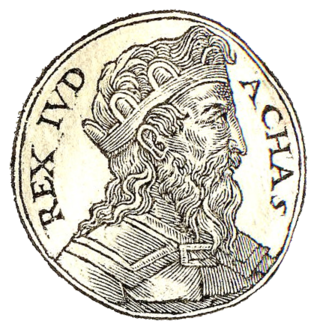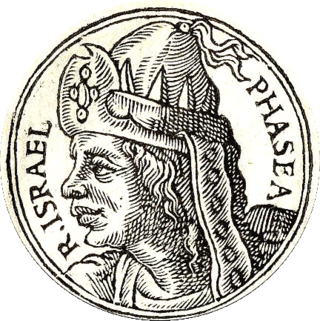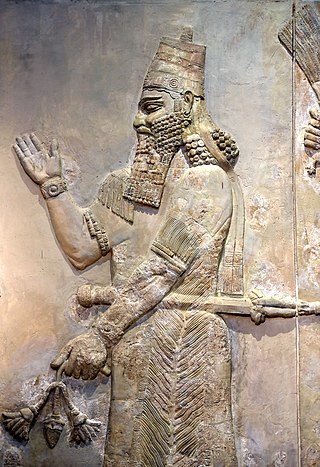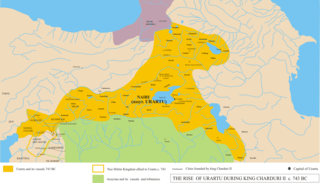This article concerns the period 739 BC – 730 BC.

Ahaz an abbreviation of Jehoahaz II, "Yahweh has held" was the twelfth king of Judah, and the son and successor of Jotham. Ahaz was 20 when he became king of Judah and reigned for 16 years.

Tiglath-Pileser III was the king of the Neo-Assyrian Empire from 745 BC to his death in 727. One of the most prominent and historically significant Assyrian kings, Tiglath-Pileser ended a period of Assyrian stagnation, introduced numerous political and military reforms and more than doubled the lands under Assyrian control. Because of the massive expansion and centralization of Assyrian territory and establishment of a standing army, some researchers consider Tiglath-Pileser's reign to mark the true transition of Assyria into an empire. The reforms and methods of control introduced under Tiglath-Pileser laid the groundwork for policies enacted not only by later Assyrian kings but also by later empires for millennia after his death.

Pekah was the eighteenth and penultimate king of Israel. He was a captain in the army of king Pekahiah of Israel, whom he killed to become king. Pekah was the son of Remaliah.

Sargon II was the king of the Neo-Assyrian Empire from 722 BC to his death in battle in 705. Probably the son of Tiglath-Pileser III, Sargon is generally believed to have become king after overthrowing Shalmaneser V, probably his brother. He is typically considered the founder of a new dynastic line, the Sargonid dynasty.

Menahem or Menachem was the sixteenth king of the northern Israelite Kingdom of Israel. He was the son of Gadi, and the founder of the dynasty known as the House of Gadi or House of Menahem.
Tiglath-Pileser II was King of Assyria from 967 BCE, when he succeeded his father Ashur-resh-ishi II, until his death in 935 BCE, when he was succeeded by his son Ashur-dan II. Little is known about his reign.

Tiglath-Pileser I was a king of Assyria during the Middle Assyrian period. According to Georges Roux, Tiglath-Pileser was "one of the two or three great Assyrian monarchs since the days of Shamshi-Adad I". He was known for his "wide-ranging military campaigns, his enthusiasm for building projects, and his interest in cuneiform tablet collections". Under him, Assyria became the leading power of the Ancient Near East, a position the kingdom largely maintained for the next five hundred years. He expanded Assyrian control into Anatolia and Syria, and to the shores of the Mediterranean Sea. From his surviving inscriptions, he seems to have carefully cultivated a fear of himself in his subjects and in his enemies alike.
Ashur-nirari V was the king of the Neo-Assyrian Empire from 755 BC to his death in 745 BC. Ashur-nirari was a son of Adad-nirari III and succeeded his brother Ashur-dan III as king. He ruled during a period of Assyrian decline from which few sources survive. As such his reign, other than broad political developments, is poorly known.

The Kingdom of Aram-Damascus was an Aramean polity that existed from the late-12th century BCE until 732 BCE, and was centred around the city of Damascus in the Southern Levant. Alongside various tribal lands, it was bounded in its later years by the polities of Assyria to the north, Ammon to the south, and Israel to the west.
Šamsi was an Arab queen who reigned in the Ancient Near East, in the 8th century BCE. She succeeded Queen Zabibe. Tiglath-Pileser III, son of Ashur-nirari V and king of Assyria, was the first foreign ruler to bring the Arabs under his control. When Šamsi rebelled against him by joining an alliance forged by Rakhianu of Damascus, Pileser attacked and defeated Samsi, made her and her alliance partners surrender, and pay a tribute to remain in power. She ruled for 20 years and her successor was Queen Iatie, in about 700 BC.
Rusa I was a King of Urartu. He succeeded his father, king Sarduri II. His name is sometimes transliterated as Rusas or Rusha. He was known to Assyrians as Ursa and possibly Urzana. His birth name may have been Uedipri.

The Neo-Assyrian Empire arose in the 10th century BC. Ashurnasirpal II is credited for utilizing sound strategy in his wars of conquest. While aiming to secure defensible frontiers, he would launch raids further inland against his opponents as a means of securing economic benefit, as he did when campaigning in the Levant. The result meant that the economic prosperity of the region would fuel the Assyrian war machine.

The Neo-Assyrian Empire was the fourth and penultimate stage of ancient Assyrian history. Beginning with the accession of Adad-nirari II in 911 BC, the Neo-Assyrian Empire grew to dominate the ancient Near East and parts of South Caucasus, North Africa and East Mediterranean throughout much of the 9th to 7th centuries BC, becoming the largest empire in history up to that point. Because of its geopolitical dominance and ideology based in world domination, the Neo-Assyrian Empire has been described as the first world empire in history. It influenced other empires of the ancient world culturally, administratively, and militarily, including the Neo-Babylonians, the Achaemenids, and the Seleucids. At its height, the empire was the strongest military power in the world and ruled over all of Mesopotamia, the Levant and Egypt, as well as parts of Anatolia, Arabia and modern-day Iran and Armenia.

The Urartu–Assyria War was a conflict between the Kingdom of Urartu and the Neo-Assyrian Empire. The war began around 714 BC, with the invasion of Urartu by the Assyrian King Sargon II. Sargon led multiple offensives deep into Urartian territory, amassing numerous victories in the war. Following his death, however, Urartian Kings Argishti II and Rusa II launched many successful counterattacks, reclaiming Urartu's lost territory and gaining some from Assyria. However, their successors suffered multiple major defeats, resulting in Urartu becoming an Assyrian client state.

Kummuh was an Iron Age Neo-Hittite kingdom located on the west bank of the Upper Euphrates within the eastern loop of the river between Melid and Carchemish. Assyrian sources refer to both the land and its capital city by the same name. The city is identified with the classical-period Samosata, which has now been flooded under the waters of a newly built dam. Urartian sources refer to it as Kummaha. The name is also attested in at least one local royal inscription dating to the 8th century BCE. Other places that are mentioned in historical sources as lying within Kummuh are lands of Kištan and Halpi, and cities of Wita, Halpa, Parala, Sukiti and Sarita(?). Kummuh bordered the kingdoms of Melid to the north, Gurgum to the west and Carchemish to the south, while to the east it faced Assyria and later Urartu.

Bit Agusi or Bit Agushi was an ancient Aramaean Syro-Hittite state, established by Gusi of Yakhan at the beginning of the 9th century BC. It had included the cities of Arpad, Nampigi (Nampigu) and later on Aleppo Arpad was the capital of the state-kingdom. Bit Agusi stretched from the A'zaz area in the north to Hamath in the south.

The timeline of ancient Assyria can be broken down into three main eras: the Old Assyrian period, Middle Assyrian Empire, and Neo-Assyrian Empire. Modern scholars typically also recognize an Early period preceding the Old Assyrian period and a post-imperial period succeeding the Neo-Assyrian period.

The Sargonid dynasty was the final ruling dynasty of Assyria, ruling as kings of Assyria during the Neo-Assyrian Empire for just over a century from the ascent of Sargon II in 722 BC to the fall of Assyria in 609 BC. Although Assyria would ultimately fall during their rule, the Sargonid dynasty ruled the country during the apex of its power and Sargon II's three immediate successors Sennacherib, Esarhaddon and Ashurbanipal are generally regarded as three of the greatest Assyrian monarchs. Though the dynasty encompasses seven Assyrian kings, two vassal kings in Babylonia and numerous princes and princesses, the term Sargonids is sometimes used solely for Sennacherib, Esarhaddon and Ashurbanipal.

2 Kings 16 is the sixteenth chapter of the second part of the Books of Kings in the Hebrew Bible or the Second Book of Kings in the Old Testament of the Christian Bible. The book is a compilation of various annals recording the acts of the kings of Israel and Judah by a compiler in the seventh century BCE with a supplement added in the sixth century BCE. This chapter records the events during the reign of Ahaz, the king of Judah.














